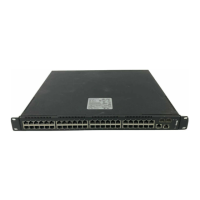Layer 2,3,IPv6+QoS Switch
_____________________________________________________________________________
Layer 2,3,IPv6+QoS Network Switch User Manual Version 0.1 Page: 892/970
Router ID - The 32 bit integer in dotted decimal format that uniquely identifies the router
within the autonomous system (AS). The Router ID is set on the OSPFv3 Interface
Configuration page. If you want to change the Router ID you must first disable OSPFv3.
After you set the new Router ID, you must re-enable OSPFv3 to have the change take
effect. The default value is 0.0.0.0, although this is not a valid Router ID.
Area ID - The ID of an OSPFv3 area to which one of the router interfaces is connected. An
Area ID is a 32 bit integer in dotted decimal format that uniquely identifies the area to
which an interface is connected.
LSA Type - The format and function of the link state advertisement. One of the following:
•
Router Links
•
Network Links
•
Network Summary
•
ASBR Summary
•
AS-external
LS ID - The Link State ID identifies the piece of the routing domain that is being described
by the advertisement. The value of the LS ID depends on the advertisement's LS type.
Age - The time since the link state advertisement was first originated, in seconds.
Sequence - The sequence number field is a signed 32-bit integer. It is used to detect old
and duplicate link state advertisements. The larger the sequence number, the more recent
the advertisement.
Checksum - The checksum is used to detect data corruption of an advertisement. This
corruption can occur while an advertisement is being flooded, or while it is being held in a
router's memory. This field is the checksum of the complete contents of the advertisement,
except the LS age field.
Options - The Options field in the link state advertisement header indicates which optional
capabilities are associated with the advertisement.
Rtr Options - The router specific options.
Command Buttons
Refresh - Refresh the data on the screen with the present state of the data in the switch.

